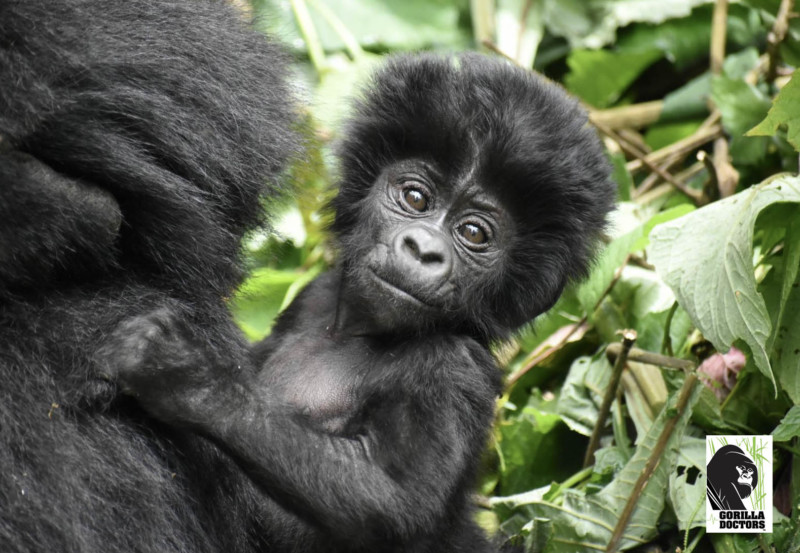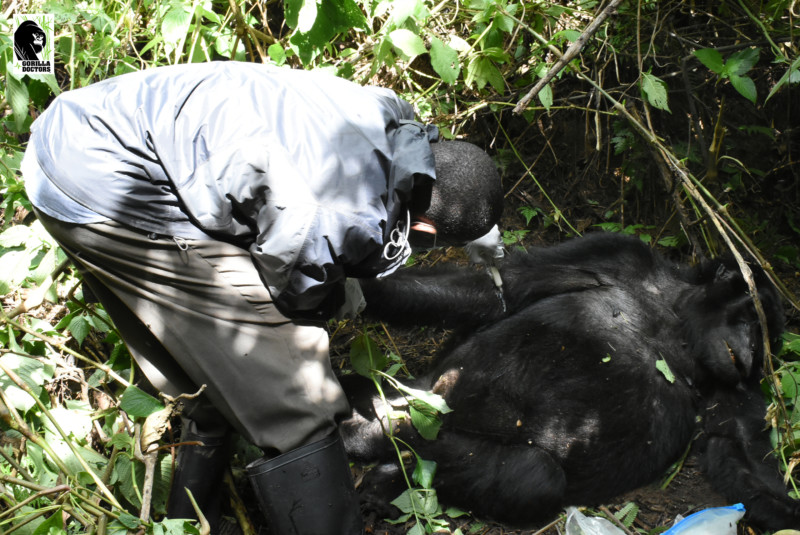BREAKING: New Mountain Gorilla Numbers Announced!
By Gorilla Doctors Staff on Monday, December 16th, 2019 in Blog.Today in Kampala, Uganda (+11 hours ahead of PST), the Uganda Wildlife Authority announced the results of the 2018 Bwindi-Sarambwe mountain gorilla population survey, with mountain gorillas in this region increasing to a minimum of 459. When combined with the 2015-2016 population survey results in the Virunga Massif (604), the total world population of endangered mountain gorillas now stands at 1,063.
“Mountain gorillas are the only great ape in the wild whose numbers are increasing and this is wonderful news,” stated Dr. Kirsten Gilardi, Gorilla Doctors’ Executive Director and Chief Veterinary Officer. “But the total population number of mountain gorillas is small, so it’s critical that we all continue to focus on their conservation.”

Infant mountain gorilla, Katwe group, Bwindi Impenetrable National Park, Uganda. Photo by Gorilla Doctor Fred Nizeyimana.
Gorilla Doctors provides life-saving veterinary care to mountain gorillas in Uganda, Rwanda and DR Congo and is credited for half of the annual population growth rate of human-habituated mountain gorillas. In Uganda alone, between July 2018 – July 2019, Gorilla Doctors conducted 126 health checks and performed 23 veterinary interventions to treat ill and injured mountain gorillas. “Given ongoing risks to mountain gorillas such as habitat encroachment, potential disease transmission, poaching and civil unrest, this increase should serve as both a celebration and a clarion call to all government, NGO and institutional partners to continue to collaborate in our work to ensure the survival of mountain gorillas,” Gilardi continued.

Dr. Fred performs emergency snare removal on adult female Shida of Mashiaya group. Bwindi Impenetrable National Park, Uganda. January 2019.
Gorilla Doctors & UC Davis Play Important Role in Census
As part of an international team of collaborators led by Uganda Wildlife Authority (UWA) and l’Institut Congolais pour la Conservation de la Nature (ICCN) under the Greater Virunga Transboundary Collaboration (GVTC) framework, Gorilla Doctors was involved in the census throughout planning, execution and analysis. Gorilla Doctors helped train census workers and led the management and preparation of all samples collected and distributed to participating labs, including the Mammalian Ecology and Conservation Unit (MECU) at the UC Davis Veterinary Genetics Laboratory.
MECU conducted all the analyses of gorilla fecal samples collected during the census, extracting host DNA in order to differentiate among individual gorillas and thereby obtain an accurate population count. Additional fecal samples were collected and preserved by Gorilla Doctors to study the impact of pathogens, including parasites, on gorilla health.
A Note from our Executive Director
This announcement is a testament to the efforts of everyone working for mountain gorilla conservation, but I do feel especially proud of our veterinarians and their direct impact on this increase in mountain gorilla numbers. Our work is credited with half of the annual population growth rate in human-habituated mountain gorillas and with female mountain gorillas giving birth, on average, once every four to six years, each individual life is critical to the survival of the species. Every time we are able to save a gorilla from illness or injury and use our scientific research to advance our One Health approach, we contribute not only to the health of gorillas but also to people and the environments we all share.
An International Collaboration
Other key population survey collaborators included the Rwanda Development Board, International Gorilla Conservation Programme (a coalition of Conservation International, Fauna & Flora International and WWF), Max Planck Institute for Evolutionary Anthropology, The Dian Fossey Gorilla Fund, Institute of Tropical Forest Conservation, Conservation Through Public Health, Wildlife Conservation Society Uganda Country Office, WWF Uganda Country Office, and Bwindi Mgahinga Conservation Trust. The census was funded by Fauna & Flora International, WWF, and Partners in Conservation at the Columbus Zoo & Aquarium.
Support Gorilla Doctors with a year-end gift
Follow our work on Facebook, Instagram and Twitter


 Donate
Donate